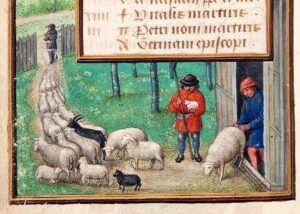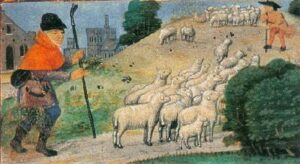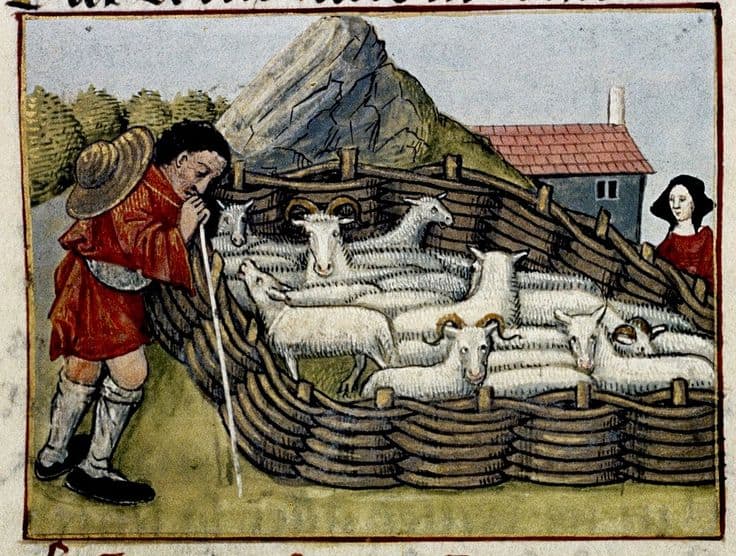Cistercian monasteries were renowned for their sheep farming and Abbey Cwmhir, with its extensive upland land holdings, would have been no exception. Unfortunately, there are no extant records of the Abbey’s sheep farming activities so evidence must come indirectly from a general understanding of the historical context and an interpretation of the archaeological features in the landscape. This post is a report of work in progress and stems from a Zoom talk given to the Abbey Cwmhir Heritage Trust and the response by its members (See Comments below).

In this post I want to focus on the general context of sheep farming while recognising that other stock such as horses, cattle, pigs, and arable farming also contributed significantly to the medieval agricultural economy in a complex interplay which would have been dictated, in part, by topography. Sheep provided meat, skins, milk, manure and, economically most importantly, wool.
Sheep farming has a long history before the Cistercians founded Abbey Cwmhir. However, they were in the forefront in the development of organisation and sheep management methods. In this the Cistercians of Abbey Cwmhir benefitted from being part of the much wider network of the Cistercian Order by which knowledge and good practice could be disseminated. As a result, the Cistercians became famous for the quality of their wool and were able to sell it at premium prices.
For many monasteries the possession of holy relicts attracted large numbers of pilgrims who provided an income stream. Abbey Cwmhir had only one known relic, a now lost painting of Jesus, which attracted few. Its primary income would have come from exploiting its extensive land holding, both by directly farming the land or, increasingly over the period of its ownership, by rent from independent tenant farmers, themselves involved in sheep farming.
During the 350 or so years of its activity, the wool trade evolved. Wool was a valuable and easily transported commodity attracting continental buyers. These traders valued the association with monasteries as centres where they could bulk-buy wool washed and graded. The monasteries were exempt from many toll charges so the buyers could also benefit from the sellers delivering the wool to the ports.

The dependence on the traders could cause problems for the Abbeys. Major Italian traders would offer deals of down payments with further annual payments for the wool produced. Abbots, not all of whom were financially acute, found the allure of ready money and reliable future payments, for as many as 20 years, irresistible. However, wool production fluctuated and was subject to disease. Non-compliance with the contracts could lead to heavy fines and, effectively, to the bankruptcy of some monasteries. By contrast the Italian houses grew rich and became the first recognisable international banks, lending to kings and financing wars.
Within this broad context, sheep husbandry was widely practiced on the land holdings of Abbey Cwmhir. The individual farms, with few exceptions, consisted of upland sheepwalks and adjacent enclosed field below. This made it logistically simple to move sheep between upland pasture and enclosed field or folds. This contrasts with sheep being seasonably moved large distances, often hundreds of miles, with their owners – a process known as transhumance.


Sheep farming was an incredibly profitable activity not only here in Wales or Cistercian Monastic areas but also in East Anglia and the Cotswolds. In East Anglia the ‘wool ‘churches are testament to the wealth generated, eg at Long Melford or Lavenham. In the Cotswolds notable examples include Northleach and Winchcombe. The Textile Museum in Newtown traces the wool industry in Mid Wales from cottage to International before it’s final collapse in the twentieth century. Would that wool were such an important commodity today.
The following Comment has been made on behalf of Maureen Lloyd and has been taken from an email which she has sent.
……………………….
I have looked at the sale of a neighbouring farm to ours, sold as a freehold sheep walk with a couple of fields plus a cottage and garden. It was sold in May 1919 and it was generally a swathe of land: a ridge of 80 odd acres which was open with adjoining the common land. I would be very interested to know the size of the various sheep walks identified with each holding at ACH and also where were the common lands did they adjoin? I know you have the enclosures so I think it would be useful to look at the whole area from a sheep farming point of view.
Where I grew up sheep walks referred to an area of common land that your sheep, i.e. their hefts, should be grazing on, so it is important to understand the different use of these terms.
The sheep walks of ACH were like the only one I have come across here, which is an area of pretty rough ground providing a link from the low-lying ground in the valley and the open common land which everyone would have had rights to. Ours had no buildings associated with it, just a cottage near the edge of the common and the sheep walk and a garden etc.
I would like to look through some of the sales catalogues of some of the estates to see if there are other examples of these sheep walks and their positions etc. Do we know that the Cistercians farmed all the area directly or did they lease out some of the farms to tenants? I would suggest that sheep would be moved up onto the common land in the summer and wintered on the sheep walks perhaps. I would not be surprised if cattle were not grazed on those sheep walks during the summer and perhaps some of the fields adjoining being used for hay, although it is possible a hay crop could have been taken from the sheep walk I suppose if the ground was suitable which I suppose with human labour you would not have the problem of over-turning tractors etc.
• Hill farming has been going on for many many centuries. I think there are a few points:
• The Cistercians farmed sheep mostly I think for wool
• the colder the temperature the more wool a sheep grows.
• Sheep can withstand cold very well, wool is not so good with a long spell of very heavy rain but again the thicker the fleece the longer time it takes for rain to penetrate to the sheep’s skin.
Up until WW2 there were a lot of sheep kept on the hills, there would be the ewes which would possibly come down to lower ground during the latter part of the winter and for lambing. The ewe lambs would join the flock and would produce lambs themselves on their second winter. The male lambs would be castrated and they would be kept on the hill until they may be 3 or 4 years old, they would be sheared each year and then they would be sold for mutton after perhaps 3 or 4 years. They were the sheep that would help to keep the heft as they would be on the hill all the year around.
So it is possible that the ewe flock may not have been that big, some rough maths from my head:-
• Year 1 100 ewes, 80 lambs 40 females 40 males, go back up the mountain,
• Year 2 100 ewes have another 80 lambs 40 and 40.
• Year 3 140 ewes although they probably would actually still be only 100 as sheep are pretty good at dying so I think we can use those 40 females to just keep the flock at its normal level of 100. So assuming the ewe lambs keep the flock maintained at normal level
• Year 4 100 ewes but the wethers would still be on the hill they would be roughly 120 plus 40 ewe lambs from previous spring by then so you are in a position where probably less than half of the flock would have lambs.
So, from these very rough figures, a full flock of sheep with 100 ewes would be about 250 sheep in total. This demonstrates that you would only need to provide shelter for about 40% of the flock, (the ewes), as the wethers and the hoggs (first year ewe lambs) could be overwintered on the higher hills.
These are rough figures, I don’t know what % lambing figures would have been customary but I do know that on a bad winter there could have been substantial losses of lambs and ewes with snow drifts etc.
Of course, none of this helps dating any of those sites as hill farming has been going on in similar fashion for so long. There is not a lot of choices when you farm in the hills, much the same in 1200 as in 2000.
Added note: Possibly my figures are a bit on the conservative side in thinking that 40% would be needed as replacements I think the general figure used was about 25% however there tends to be a lot of difference between good and bad years. Some years might be a disaster with snow etc when nearly all lambs could be wiped out, so perhaps my estimates might not be far out.